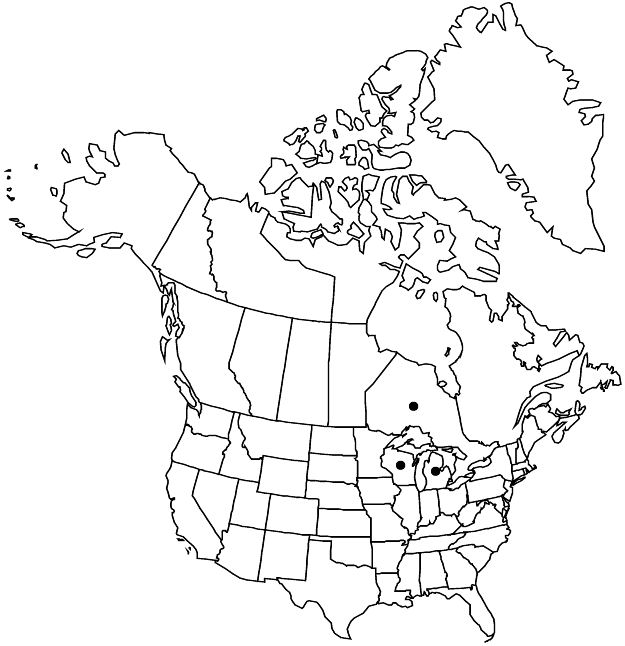familyRosaceae
subfamilyRosaceae subfam. Amygdaloideae
genusCrataegus
sectionCrataegus sect. Coccineae
speciesCrataegus coccinea
Difference between revisions of "Crataegus coccinea var. fulleriana"
Phytoneuron 2011–29: 1. 2011.
Endemic
Basionym: Crataegus fulleriana Sargent Proc. Rochester Acad. Sci. 4: 111. 1903
Synonyms: C. chippewaensis Sargent C. holmesina var. chippewaensis (Sargent) E. J. Palmer C. illecebrosa Sargent
FNA>Volume Importer |
FNA>Volume Importer |
||
| Line 11: | Line 11: | ||
|label=Endemic | |label=Endemic | ||
}} | }} | ||
| − | |basionyms={{Treatment/ID/ | + | |basionyms={{Treatment/ID/Basionym |
|name=Crataegus fulleriana | |name=Crataegus fulleriana | ||
|authority=Sargent | |authority=Sargent | ||
| + | |publication_title=Proc. Rochester Acad. Sci. | ||
| + | |publication_place=4: 111. 1903 | ||
}} | }} | ||
|synonyms={{Treatment/ID/Synonym | |synonyms={{Treatment/ID/Synonym | ||
| Line 39: | Line 41: | ||
|elevation=10–300 m | |elevation=10–300 m | ||
|distribution=Ont.;Mich.;Wis. | |distribution=Ont.;Mich.;Wis. | ||
| − | |discussion=<p>The leaf shape of <i></i>var.<i> fulleriana</i> is somewhat intermediate between <i></i>var.<i> coccinea</i>, <i></i>var.<i> pringlei</i>, and <i>Crataegus holmesiana</i>. In J. A. Macklin (2001), the placement of <i></i>var.<i> fulleriana</i> indicates it is not simply a 20-stamen variant of one of the 5–10-stamen entities. <i>Crataegus</i> confragosa Sargent may represent a glabrate form. Very rare convex-leaved forms might also be interpreted as mutants of <i></i>var.<i> pringlei</i>.</p> | + | |discussion=<p>The leaf shape of <i></i></i>var.<i><i> fulleriana</i> is somewhat intermediate between <i></i></i>var.<i><i> coccinea</i>, <i></i></i>var.<i><i> pringlei</i>, and <i>Crataegus holmesiana</i>. In J. A. Macklin (2001), the placement of <i></i></i>var.<i><i> fulleriana</i> indicates it is not simply a 20-stamen variant of one of the 5–10-stamen entities. <i>Crataegus</i> confragosa Sargent may represent a glabrate form. Very rare convex-leaved forms might also be interpreted as mutants of <i></i></i>var.<i><i> pringlei</i>.</p> |
|tables= | |tables= | ||
|references= | |references= | ||
| Line 63: | Line 65: | ||
|publication year=2011 | |publication year=2011 | ||
|special status=Endemic | |special status=Endemic | ||
| − | |source xml=https://jpend@bitbucket.org/aafc-mbb/fna-data-curation.git/src/ | + | |source xml=https://jpend@bitbucket.org/aafc-mbb/fna-data-curation.git/src/f6b125a955440c0872999024f038d74684f65921/coarse_grained_fna_xml/V9/V9_949.xml |
|subfamily=Rosaceae subfam. Amygdaloideae | |subfamily=Rosaceae subfam. Amygdaloideae | ||
|tribe=Rosaceae tribe Gillenieae | |tribe=Rosaceae tribe Gillenieae | ||
Revision as of 20:39, 24 September 2019
Leaf blades broadly elliptic to elliptic-ovate, 4–7 cm (length/width = 1.2), usually plane, rarely concavo-convex, base rounded to broadly cuneate, lobe sinuses often shallow. Stamens 20. Pomes usually suborbicular.
Phenology: Flowering May; fruiting Sep–Oct.
Habitat: Brush, woodland margins, fencerows, overgrown pastures
Elevation: 10–300 m
Distribution

Ont., Mich., Wis.
Discussion
The leaf shape of var. fulleriana is somewhat intermediate between var. coccinea, var. pringlei, and Crataegus holmesiana. In J. A. Macklin (2001), the placement of var. fulleriana indicates it is not simply a 20-stamen variant of one of the 5–10-stamen entities. Crataegus confragosa Sargent may represent a glabrate form. Very rare convex-leaved forms might also be interpreted as mutants of var. pringlei.
Selected References
None.
Lower Taxa
None.